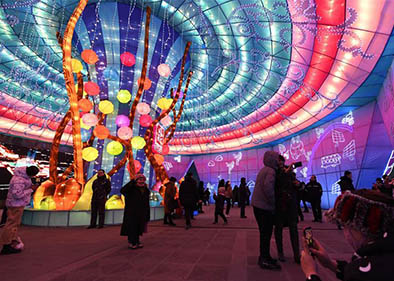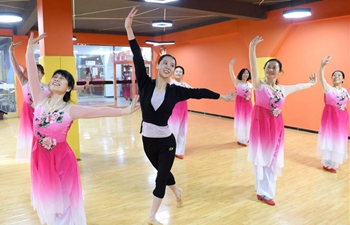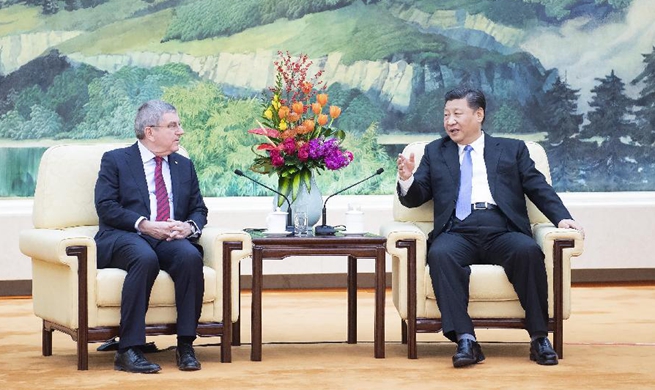by Xinhua writers Guo Ying, Sun Qi
BEIJING, Feb. 1 (Xinhua) -- While the blind and visually impaired are able to learn and understand texts through Braille, there are very limited tools to help them understand visual information.
Chinese researchers have designed a prototype tactile display system that allows them to handle visual information efficiently, hoping they can benefit more from the Internet age of booming graphic information.
Named "Graille" and developed by Tsinghua University, the prototype includes a computer and an unusual display. The display is comprised of a pin-matrix with 7,200 small tactile dots that can be raised and retracted.
The computer controls the pin-matrix of the display to show graphic information in raised tactile dots, which can be read by touch by the blind users.
With a self-lock structure, the raised pattern can be locked for reading. The display is refreshable and allows users to feel a succession of images.
Graille has a touch guidance interface, which offers a multi-channel interactive experience by introducing both haptic and audio experience.
The research and development of the prototype was led by Xu Yingqing, a professor and director of the Future Lab in Tsinghua University.
"We have applied for patents and hope it can be commercialized soon," Xu said.
The prototype was a result of years of research and exploration. The idea started in 2009 when Xu, an expert in computer vision and interaction design, was working on a digitalization project for cultural heritage.
Xu noticed that blind visitors can only absorb information through voice introduction converted from texts. The lack of visual information makes it hard for them to appreciate museum exhibits.
Xu's team also visited the Beijing School for the Blind to learn more about blind people's need for handling visual information.
"Visual information is vital for their life and education. For those who want to be massage therapists, they have to bear in mind the pictures of human anatomy," Xu said.
Xu said he came across many blind students who were eager to learn more through computers and the Internet.
"However, in an Internet age burgeoning with online visual information such as pictures and videos, there is a widening information gap between them and sighted users. We need to make visual content more accessible to them," Xu said.
How to make tactile image readable for the visually impaired is essential for the development of the computer.
Xu said the tactile image on the display is more than just mapping the outlines of the pictures as blind people have a different recognition of tactile images.
Gong Jiangtao, a Ph.D student in Tsinghua is responsible for the graphic design of the computer. In order to get more first-hand knowledge of blind people's visual cognition, she spent about 500 hours interacting with blind students.
"It's hard for them to understand perspective so when we want to present a three-dimensional objects, we may choose one or more surfaces to represent it. Besides, symmetrical images are more recognizable for them," Gong said.
Gong and her team set up a field study on 242 tactile images featuring common objects and test whether the designs were suitable for blind people's tactile cognition.
They then used machine learning methods to analyze large amount of feedback and summarized 22 features that may cause difficulty in tactile recognition. The results worked as universal design principles of tactile images and more images might be generated with artificial intelligence technology.
Xu emphasized that the success of the prototype lied in interdisciplinary research that involved experts from design, computer science, psychology and medical science.
"For example, we can conduct fMRI images of brain activity to gain better understanding of the cognitive mechanisms of tactile images," Xu said.
His team is also cooperating with Internet companies including Baidu and Alibaba to benefit blind users in more areas.
"We hope that with the function of online surfing, the visual tactile display system may be expanded as an application such as in online shopping," Xu said.
Yang Guang, a blind student from the Special Education College of Beijing Union University, was excited when he used the system to choose his favorite mug from six mugs with different patterns on a shopping platform.
"In the past, I could only listen to the text description of the goods through the screen reading software, but now I can 'read' the picture description," Yang said.
The team is working on improved versions of the system and plans to roll out more miniaturized version in the future.
"We are also trying to cut the cost and make it affordable to more blind users," Xu said.
Lyu Shiming, vice chairman of the China Disabled Persons' Federation, spoke highly of the system and the team's efforts.
"The system makes visual information more accessible for blind users. With more research and innovation on the development of assistive technology for the disabled, I am full of expectation for an information society that is more inclusive of the disabled," Lyu said.

















